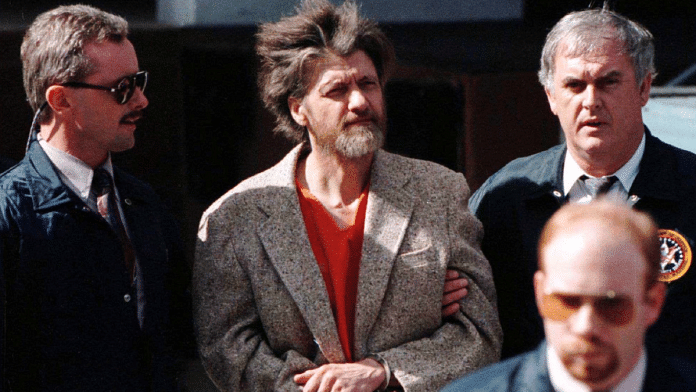New Delhi: Ted Kaczynski, the notorious Harvard-educated mathematician-turned-murderer known as the ‘Unabomber’, was found dead in his North Carolina prison cell Saturday. He was 81.
From 1978 to 1995, the lone bomber carried out 16 bombings that killed three people and injured 23. After evading arrest for two decades, Kaczynski was arrested from his isolated cabin in Montana in April 1996, and was sentenced to four life terms without parole.
Kaczynski gained notoriety during the late 1970s and 1980s for his nationwide bombing campaign. He was branded ‘Unabomber’ by the Federal Bureau of Investigation (FBI), a portmanteau of “university” and “airline bomber” — which were his early targets.
In 1995, he demanded that The Washington Post and The New York Times publish his 35,000-word manifesto, threatening to detonate a bomb at an undisclosed location if they refused. Following this, the US attorney general and the director of the FBI recommended the publication of the manifesto, which appeared in The Washington Post as an eight-page supplement separate from the news sections.
The NYT also published the manifesto, ‘Industrial Society and Its Future’, which encompassed a broad range of topics, addressing his opposition to the industrial-technological system and its perceived erosion of human freedom and dignity. Kaczynski also addressed topics, such as over-socialisation, the psychology of modern leftism, motives of scientists, nature of freedom, and more.
“Some scientific work has no conceivable relation to the welfare of the human race — most archaeology or comparative linguistics for example. Some other areas of science present obviously dangerous possibilities,” read a section from the manifesto published in The Washington Post.
His aversion to the advancement of science and technology may be a possible explanation for why he targeted universities, airlines, and people involved in technology by mailing explosive devices to avoid detection.
According to news reports, before being transferred to the prison medical facility, Kaczynski had been held in a federal supermax prison in Florence, Colorado, since May 1998, when he was sentenced to four life sentences plus 30 years for a campaign of terror that set universities nationwide on edge.
Also Read: Question ahead of Modi’s US visit—Will India abandon multipolarity, become a camp follower?
From Harvard to prison
Born in 1942 in Chicago, Illinois, Kaczynski displayed exceptional intellect from a young age. He had an IQ score between 160 and 170 and was one of the youngest students to enter Harvard at 16 years old.
After graduating from Harvard University in mathematics, he went on to obtain a PhD in the subject from the University of Michigan. He had a promising academic career ahead of him, but his mental health started to decline, leading him to move to a secluded cabin in Montana.
During his time at Harvard, he reportedly participated in a psychological study conducted by Harvard psychologist Henry Murray. These experiments, however, were later reportedly revealed to be deeply abusive, degrading, and emotionally traumatic for the participants, including Kaczynski.
While there is speculation about the potential influence of these experiences on his later criminal activities, Kaczynski himself maintained that they had “no significant effect” on his life. In his journals filed by federal prosecutors as part of their sentencing recommendations, Kaczynski wrote that the motive for his actions was simply personal revenge.
During his self-imposed isolation, Kaczynski reportedly became consumed by his anti-technology views. He began his bombing campaign in 1978 when he sent his first homemade bomb using scrap materials to Northwestern University, where an on-campus police officer was injured.
The deadly attacks came to a halt after The Washington Post and The New York Times agreed to publish his manifesto in 1995. His brother, David Kaczynski, recognised the ideologies expressed in the manifesto and subsequently alerted the FBI, which led to the arrest of the bomber at his secluded cabin in Montana.
In 1998, Kaczynski pleaded guilty to multiple federal charges, including transportation, mailing, and use of bombs, and was sentenced to life imprisonment without parole.
(Edited by Richa Mishra)
Also Read: Why Western charm offensive for Modi is proof of PM walking foreign policy middle path



